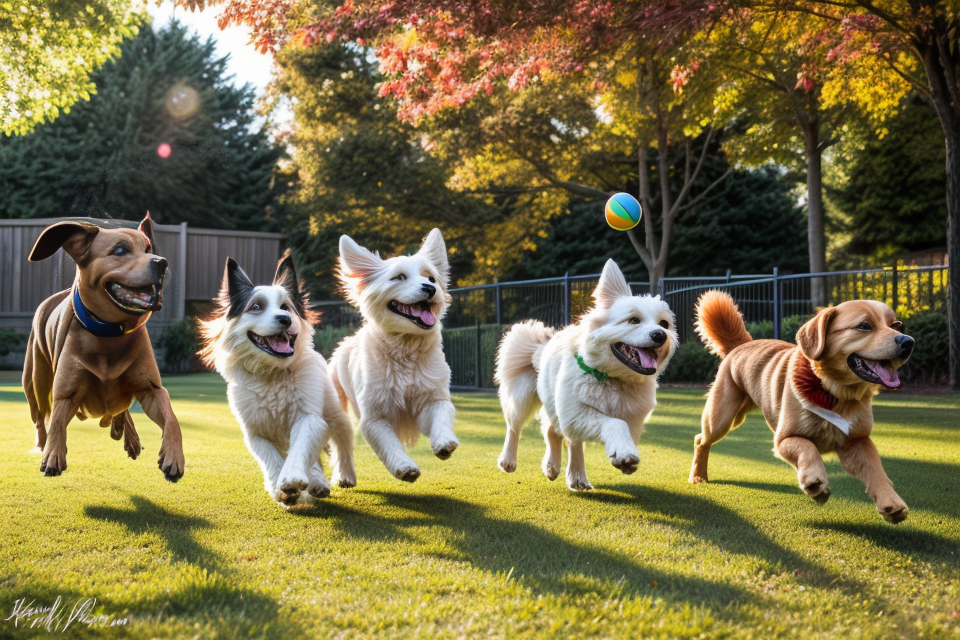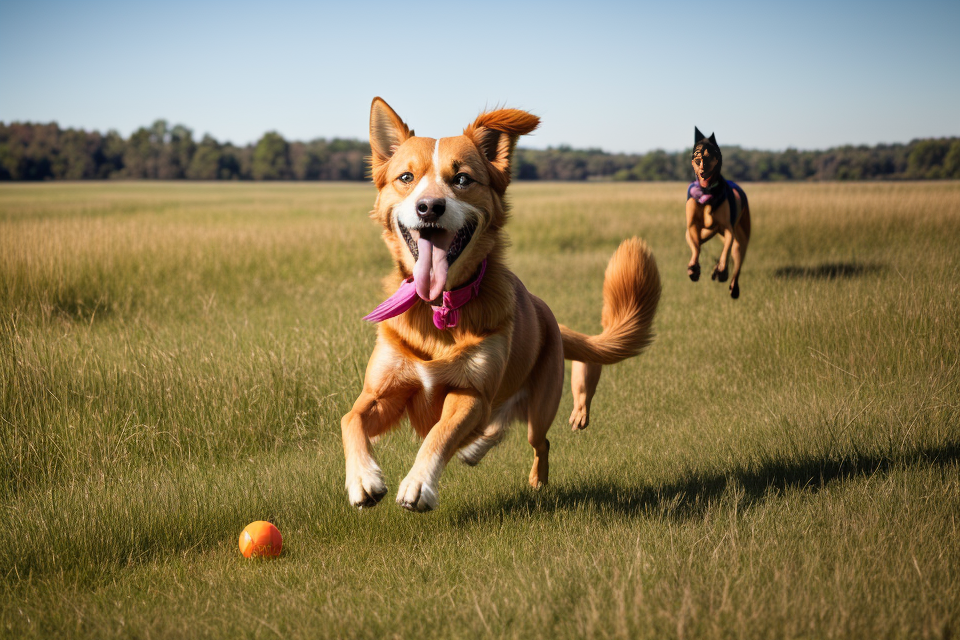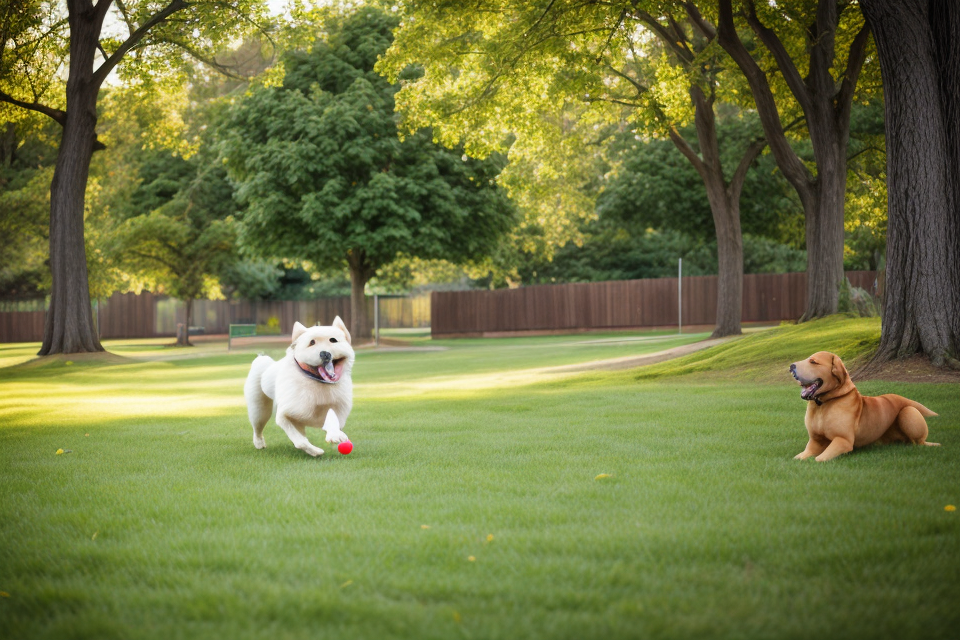Dogs are known for their keen sense of hearing and their ability to pick up on the faintest of sounds. But why are they so obsessed with squeakers? From toys to dog beds, squeakers seem to be a constant source of fascination for our furry friends. In this article, we will delve into the world of dog behavior and explore the reasons behind their fascination with squeakers. We will also discuss the different types of squeakers and how they can benefit our pets. So, get ready to learn about the fascinating world of dogs and their love for squeakers!
Understanding the Canine Love for Squeakers
The Evolutionary Theory
Pack Mentality and Hunting Instincts
One possible explanation for the canine fascination with squeakers lies in their evolutionary history. Dogs, as descendants of wolves, possess a strong pack mentality and hunting instincts. These traits were crucial for their survival in the wild, as they allowed them to cooperate with their pack members to hunt and defend their territory.
In the context of toys, squeakers can stimulate these ancient instincts by mimicking the sounds of prey, triggering a hunting response in dogs. The squeaker’s movement and sound can evoke the image of small animals like rodents or birds, which dogs would naturally pursue and capture in the wild.
Toys as Substitutes for Prey
Squeakers also serve as substitutes for the actual prey that dogs would hunt in the wild. By engaging with a squeaker toy, dogs can practice their hunting skills and satisfy their natural instinct to chase and capture prey. The movement and sound of the squeaker create an interactive experience that keeps dogs engaged and motivated to play.
Additionally, the use of squeakers in toys may provide dogs with a sense of control and mastery over their environment. By successfully “hunting” the squeaker, dogs can experience a sense of accomplishment and satisfaction, which reinforces their behavior and increases their attachment to the toy.
These evolutionary theories help explain why squeakers are so captivating to dogs, as they tap into their ancient hunting instincts and provide a satisfying outlet for their natural behaviors. Understanding these underlying mechanisms can help dog owners better appreciate their pets’ fascination with squeakers and provide appropriate outlets for their energy and instincts.
The Sensory Appeal
Auditory Delight
Dogs are known for their exceptional sense of hearing, which allows them to detect a wide range of sounds that are beyond the auditory capabilities of humans. The squeaker toy appeals to a dog’s auditory senses in several ways. Firstly, the sound produced by the squeaker is high-pitched and easily captures a dog’s attention. Secondly, the sound produced by the squeaker is distinct and consistent, making it easy for dogs to locate the source of the sound. Finally, the sound produced by the squeaker is repetitive, which creates a stimulating and enjoyable auditory experience for dogs.
Tactile Stimulation
In addition to the auditory appeal, squeaker toys also provide tactile stimulation for dogs. The squeaker is typically enclosed in a soft, plush toy that is designed to be chewed and gnawed. As dogs interact with the toy, they are able to experience different textures and sensations, which can be highly stimulating and satisfying for them. Additionally, the movement of the squeaker inside the toy creates a tactile sensation that dogs find enjoyable and engaging. This tactile stimulation is particularly important for dogs who are teething or have a high level of energy and need a way to channel their pent-up energy in a positive way.
The Science Behind the Squeaker Craze
The Brain and Emotional Response
Oxytocin and Social Bonding
Dogs have a strong affinity for squeaky toys, and this can be attributed to the role of oxytocin in their brains. Oxytocin is a neurotransmitter that plays a significant role in social bonding, and it is often referred to as the “cuddle hormone.” When dogs engage in play with their squeaky toys, they release oxytocin, which strengthens their emotional bond with their owners. This bonding process is essential for the well-being of dogs, as it provides them with a sense of security and belonging.
Endorphins and Positive Reinforcement
Squeaky toys also trigger the release of endorphins in dogs, which are natural painkillers that provide a sense of pleasure and happiness. Endorphins are associated with positive reinforcement, and they encourage dogs to repeat behaviors that led to the release of these feel-good chemicals. This reinforcement process is essential for maintaining a healthy and happy dog, as it motivates them to engage in behaviors that are beneficial for their physical and emotional well-being.
Additionally, the squeaking sound produced by squeaky toys can be stimulating for dogs, as it simulates the sound of prey. This stimulation triggers their natural instincts, making them more engaged and motivated to play. Overall, the combination of oxytocin, endorphins, and the stimulation of their natural instincts makes squeaky toys an irresistible temptation for dogs.
Breed and Individual Differences
It is essential to consider the breed and individual differences when examining the fascination dogs have with squeakers. Understanding these distinctions can provide valuable insights into why some dogs are more drawn to squeakers than others.
Terrier and Toy Breeds
Terrier and toy breeds, such as the Jack Russell Terrier or the Chihuahua, are often highly interested in squeakers. These dogs possess a strong prey drive, which makes them naturally inclined to pursue and interact with small, moving objects like squeakers. Their terrier heritage further amplifies their curiosity and determination, as they were bred for hunting and digging. This breed type is likely to spend more time playing with squeakers and less time resting.
Working and Guard Breeds
Working and guard breeds, such as German Shepherds or Belgian Malinois, typically have a different temperament and energy level compared to terrier and toy breeds. While they may not be as intrinsically motivated to chase squeakers, they are highly intelligent and easily trainable. These breeds often excel in agility, obedience, and search and rescue training, which may involve the use of squeakers as rewards or motivators. In this context, the squeaker becomes a tool for reinforcing desired behaviors rather than a toy for play.
In conclusion, breed and individual differences play a significant role in how dogs perceive and interact with squeakers. Understanding these factors can help pet owners and trainers tailor their approach to engaging and entertaining their furry companions, ensuring that the experience is enjoyable and beneficial for both the dog and the human involved.
The Role of Play and Socialization
Why Dogs Need Playtime
Mental and Physical Stimulation
Playtime serves as a crucial component in the overall well-being of dogs. It not only satisfies their primal instincts but also provides essential mental and physical stimulation. Engaging in games and activities with their owners or other dogs, canines can flex their cognitive abilities, enhance problem-solving skills, and build their confidence. Furthermore, playtime allows dogs to expend pent-up energy, promoting healthy physical development and maintaining optimal weight.
Socialization and Emotional Well-being
Dogs are social creatures, and playtime offers them the opportunity to interact with their environment and other dogs. This interaction fosters positive socialization, helping canines develop better communication skills, self-esteem, and emotional stability. Through play, dogs learn how to share, take turns, and cope with both winning and losing, which ultimately contributes to their overall emotional well-being. Moreover, regular play sessions with owners strengthen the bond between the dog and the human, fostering trust and affection.
Training Techniques for Squeaker Obsession
Positive Reinforcement
Clicker Training
Clicker training is a type of positive reinforcement training that uses a distinct sound, such as a clicker, to mark desired behaviors. By pairing the clicker sound with treats or praise, dogs learn to associate the sound with positive reinforcement and are more likely to repeat the behavior. This technique is effective in modifying behavior, as it reinforces the desired behavior and helps the dog understand what is expected of them.
Treat-Based Rewards
Treat-based rewards involve giving dogs a tasty treat as a reward for exhibiting desired behaviors. This method is a common form of positive reinforcement, as it reinforces the behavior by providing something the dog enjoys. By giving treats for good behavior, dogs learn to associate the behavior with positive outcomes and are more likely to repeat the behavior in the future. It is important to use treats that are safe for dogs and not part of their regular diet to avoid any potential health issues.
Encouraging Alternative Interests
Dogs’ obsession with squeakers can be challenging for pet owners, as it may detract from essential training and socialization. Encouraging alternative interests is a training technique that can help divert dogs’ attention from squeakers and develop other skills.
Rotating Toys
One way to encourage alternative interests is by rotating toys. By providing a variety of toys, dogs are less likely to become fixated on a single object, such as a squeaker. Rotating toys can also help prevent boredom and keep dogs mentally stimulated. To achieve this, pet owners should regularly swap out toys and introduce new ones with different textures, colors, and sounds. This technique can help dogs develop better problem-solving skills and increase their interest in their environment.
Providing Variety
Another way to encourage alternative interests is by providing variety in the dog’s environment. This can include taking the dog to different locations, such as parks, beaches, or hiking trails, and exposing them to a range of smells, sounds, and textures. Pet owners can also introduce new activities, such as agility training, scent work, or swimming, to keep dogs engaged and interested in something other than squeakers.
By providing variety and rotating toys, pet owners can help dogs develop a broader range of interests and reduce their fixation on squeakers. This technique can also help prevent destructive behavior and strengthen the bond between dogs and their owners.
Managing the Squeaker Addiction
Monitoring Health and Safety
While dogs’ love for squeakers can be a source of endless entertainment, it is essential to monitor their health and safety. As owners, we must take proactive measures to ensure that our furry companions are not negatively impacted by their squeaker obsession. Here are some potential health and safety concerns to keep an eye on:
Tooth Deterioration
Dogs who excessively chew on squeakers may be at risk for tooth deterioration. The constant pressure applied to the teeth can cause fractures, and the rough texture of the squeaker can scratch the enamel. To mitigate this risk, it is crucial to provide dogs with appropriate chew toys made from materials that are gentle on their teeth, such as rubber or rope.
Injuries and Accidents
The intense focus dogs display while chasing and biting at squeakers can lead to accidents and injuries. They may accidentally knock over objects in their path or sustain injuries from jumping and landing awkwardly. It is essential to provide a safe environment for dogs to engage in their squeaker play, free from hazards such as sharp objects or fragile items that could break and cause harm.
Additionally, owners should monitor their dogs’ behavior during squeaker play to ensure they are not becoming overly aggressive or displaying signs of stress. If a dog is consistently growling, snapping, or showing signs of distress while playing with squeakers, it may be an indication that they are experiencing excessive stress or frustration. In such cases, it may be necessary to limit or supervise their squeaker play to prevent accidents or injuries.
By monitoring our dogs’ health and safety while they enjoy their squeaker obsession, we can ensure that they remain happy and healthy while engaging in this delightful canine pastime.
Modifying Behavior through Training
Modifying behavior through training is an effective way to address a dog’s compulsive behavior towards squeakers. It involves the use of various techniques to redirect the dog’s attention and modify its behavior towards more appropriate and desirable activities.
Addressing Compulsive Behavior
The first step in modifying behavior through training is to address the compulsive behavior towards squeakers. This involves identifying the underlying cause of the behavior and providing alternative outlets for the dog’s energy and curiosity.
One effective technique is to provide the dog with a variety of toys and chews that are more satisfying and engaging than the squeaker. This can help to reduce the dog’s reliance on the squeaker and provide it with a more diverse range of activities to engage in.
Another technique is to provide the dog with more exercise and mental stimulation. This can help to reduce the dog’s boredom and frustration, which may contribute to its compulsive behavior towards squeakers.
Redirecting Attention
Redirecting the dog’s attention is another key aspect of modifying behavior through training. This involves providing the dog with alternative activities that are more appropriate and desirable than the squeaker.
One technique is to use food-based rewards to encourage the dog to engage in alternative activities. For example, the owner can provide the dog with a small piece of food every time it engages in a desired activity, such as playing with a different toy or going for a walk.
Another technique is to use positive reinforcement to encourage the dog to engage in alternative activities. This involves praising and rewarding the dog whenever it engages in a desired activity, such as playing with a different toy or going for a walk.
Overall, modifying behavior through training is a highly effective way to address a dog’s compulsive behavior towards squeakers. By providing alternative outlets for the dog’s energy and curiosity, and redirecting its attention towards more appropriate and desirable activities, owners can help their dogs to develop more balanced and healthy behaviors.
The Future of Squeaker-Obsessed Dogs
Emerging Trends in Canine Toys
Interactive Toys
As technology continues to advance, interactive toys for dogs are becoming increasingly popular. These toys are designed to not only provide mental stimulation but also physical exercise for dogs. Some examples of interactive toys include:
- Puzzle toys that require dogs to figure out how to access the treats or rewards inside
- Remote-controlled toys that can be played with by owners and dogs alike
- Toys that respond to a dog’s bark or movement
Environmentally Friendly Toys
As environmental awareness continues to grow, so does the demand for eco-friendly products. This has led to the development of canine toys made from sustainable materials such as natural rubber, recycled plastic, and biodegradable materials. These toys not only provide entertainment for dogs but also help reduce the environmental impact of pet ownership. Additionally, some companies are now offering refillable toys, which allow owners to replace the squeaker or stuffing as needed, reducing waste.
The Role of Genetics and Breeding
Ethical Considerations
As researchers continue to explore the fascination of squeakers in dogs, ethical considerations arise regarding the potential manipulation of genetics to breed dogs with heightened squeaker obsession. This raises concerns about the welfare of the dogs and the impact on the dog-human bond. It is crucial to approach this topic with caution and responsibility, ensuring that any research conducted aligns with ethical guidelines and prioritizes the well-being of the animals involved.
Future Research Directions
The investigation of the genetic factors contributing to squeaker obsession in dogs is an area of ongoing research. Future studies may focus on identifying specific genes or genetic markers associated with this behavior, which could potentially lead to the development of genetic tests to predict squeaker obsession in dogs. This knowledge may also aid in breeding programs aimed at reducing or eliminating the behavior in certain breeds. However, it is essential to consider the ethical implications of such research and ensure that it is conducted responsibly and with the welfare of the dogs in mind.
In addition to genetic research, future studies may explore the environmental factors that influence squeaker obsession in dogs. Understanding how environmental factors interact with genetic predispositions can provide valuable insights into the development of this behavior and help identify potential interventions to reduce or redirect the focus of squeaker obsession.
Overall, the future of squeaker-obsessed dogs involves a combination of genetic research, responsible breeding practices, and a deeper understanding of the environmental factors that contribute to this behavior. By approaching this topic with a focus on both the welfare of the dogs and the human-dog bond, researchers can work towards developing effective strategies to manage and potentially reduce squeaker obsession in dogs.
FAQs
1. Why are dogs so interested in squeakers?
Squeakers are a type of toy that makes a high-pitched sound when squeezed or shaken. Dogs are naturally attracted to this sound because it resembles the sound of prey, such as a mouse or a bird. The sound is also a source of novelty and excitement for dogs, which can make them even more interested in the toy. Additionally, squeakers often have a satisfying texture and feel, which can make them even more enjoyable for dogs to play with.
2. Is it normal for dogs to be obsessed with squeakers?
Yes, it is normal for dogs to be obsessed with squeakers. In fact, many dogs love squeakers so much that they will do anything to get their paws on one. This obsession is often a sign of a healthy and playful dog, and it can be a great way to provide mental stimulation and exercise for your furry friend.
3. Can squeakers be bad for dogs?
While squeakers are generally safe for dogs, there are some potential risks to be aware of. If your dog chews on the squeaker, it could potentially break off and become a choking hazard. Additionally, if your dog plays with the squeaker for an extended period of time, it could become a source of frustration or even aggression if they are unable to get the sound out of it. It’s important to supervise your dog when they are playing with squeakers and to replace the toy if it becomes damaged or no longer working.
4. How can I encourage my dog’s love of squeakers?
There are many ways to encourage your dog’s love of squeakers. One of the best ways is to provide them with a variety of different squeakers to play with, each with its own unique sound and texture. You can also hide the squeakers around the house or yard and encourage your dog to find them, which can provide mental stimulation and exercise. Additionally, you can try incorporating squeakers into playtime games, such as fetch or tug-of-war, to make them even more fun and engaging for your dog.



